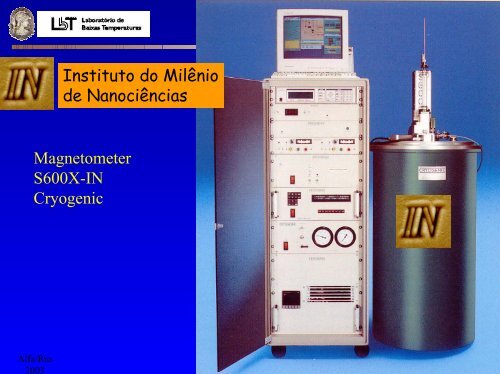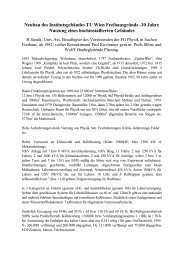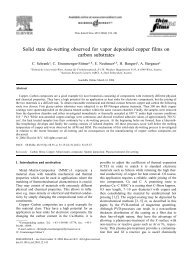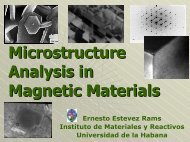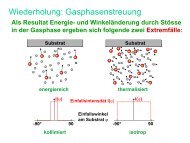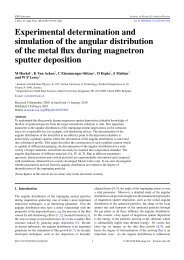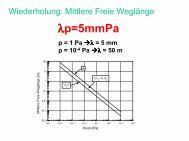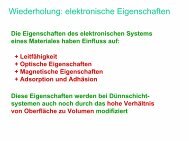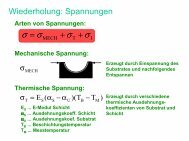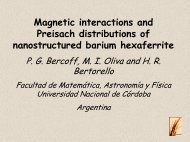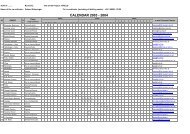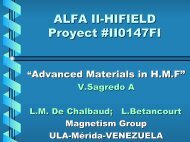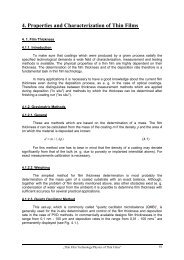Magnetometer S600X-IN Cryogenic Instituto do Milênio de ...
Magnetometer S600X-IN Cryogenic Instituto do Milênio de ...
Magnetometer S600X-IN Cryogenic Instituto do Milênio de ...
You also want an ePaper? Increase the reach of your titles
YUMPU automatically turns print PDFs into web optimized ePapers that Google loves.
Alfa/Rio<br />
2003<br />
<strong>Instituto</strong> <strong>do</strong> Milênio<br />
<strong>de</strong> Nanociências<br />
<strong>Magnetometer</strong><br />
<strong>S600X</strong>-<strong>IN</strong><br />
<strong>Cryogenic</strong>
Alfa/Rio<br />
2003<br />
Magnetometry:<br />
Squid magnetometry (not high field, < 8T)<br />
Based on Superconductivity, unbeatable at low fields<br />
Vibrating Sample magnetometry<br />
Accurate and sensitive at high fields<br />
Hall probe magnetometry<br />
Not absolute, but very sensitive, small samples, even at<br />
high fields<br />
Others: Extraction, Cantilever, Gradient field, AGM,....
Alfa/Rio<br />
2003<br />
SQUID Magnetometry<br />
Based on Meissner effect, Magnetic Flux quantization and Josephson effect<br />
Superconductivity review<br />
K.H.Onnes, 1911, R=0<br />
Not only R=0! But also B=0<br />
Meissner effect, 1933<br />
Theory BCS, 1957,<br />
Josephson Effect
The Meissner Effect<br />
Perfect Diamagnet.<br />
If a conductor already had a steady<br />
magnetic field through it and was then<br />
cooled through the transition to a zero<br />
resistance state, becoming a perfect<br />
diamagnet, the magnetic field would be<br />
expected to stay the same.<br />
Alfa/Rio<br />
2003<br />
Superconductor<br />
Remarkably, the magnetic behavior<br />
of a superconductor is distinct<br />
from perfect diamagnetism. It will<br />
actively exclu<strong>de</strong> any magnetic field<br />
present when it makes the phase<br />
change to the superconducting<br />
state.
Alfa/Rio<br />
2003<br />
A conductor will oppose any change in externally<br />
applied magnetic field. Circulating currents will<br />
be induced to oppose the buildup of magnetic<br />
field in the conductor (Lenz's law). In a solid<br />
material, this is called diamagnetism, and a perfect<br />
conductor would be a perfect diamagnet. That is,<br />
induced currents in it would meet no resistance, so<br />
they would persist in whatever magnitu<strong>de</strong><br />
necessary to perfectly cancel the external field<br />
change. A superconductor is a perfect diamagnet,<br />
but there is more than this involved in the<br />
Meissner effect.
Alfa/Rio<br />
2003<br />
SQUID<br />
Superconducting Quantum Interference Device (1970) (SQUID)<br />
•Flux quantization in a ring φ 0<br />
=(nh/2e)<br />
•Josephson Effect
Alfa/Rio<br />
2003<br />
Flux Quantization<br />
In 1961 Deaver and Fairbank did<br />
experiments with a tiny superconducting<br />
cylin<strong>de</strong>r ma<strong>de</strong> by electroplating tin on a<br />
copper wire. They found magnetic flux<br />
quantized in units of<br />
such that the flux through the<br />
cylin<strong>de</strong>r was given by
Alfa/Rio<br />
2003<br />
Josephson Junction<br />
Two superconductors separated by a thin insulating layer can experience tunneling<br />
of Cooper pairs of electrons through the junction. In the DC Josephson effect, a<br />
current proportional to the phase difference of the wavefunctions can flow in the<br />
junction in the absence of a voltage. In the AC Josephson effect, a Josephson<br />
junction will oscillate with a characteristic frequency which is proportional to the<br />
voltage across the junction. Since frequencies can be measured with great accuracy, a<br />
Josephson junction <strong>de</strong>vice has become the standard measure of voltage.<br />
If two superconductors are separated by a thin insulating layer, then quantum<br />
mechanical tunneling can occur for the Cooper pairs without breaking up the pairs..<br />
Un<strong>de</strong>r these conditions, a current will flow through the junction in the absence of an<br />
applied voltage (the DC Josephson effect).
Alfa/Rio<br />
2003<br />
Josephson Voltage Standard<br />
When a DC voltage is applied to a Josephson junction,<br />
an oscillation of frequency<br />
occurs at the junction. Since this relationship of voltage<br />
to frequency involves only fundamental constants and<br />
since frequency can be measured with extreme<br />
accuracy.<br />
The standard volt is now <strong>de</strong>fined as the voltage<br />
required to produce a frequency of 483,597.9 GHz.<br />
Josephson junction standards can yield voltages with<br />
accuracies of one part in 10^10. NIST has produced a<br />
chip with 19000 series junctions to measure voltages on<br />
the or<strong>de</strong>r of 10 volts with this accuracy.
Alfa/Rio<br />
2003
Alfa/Rio<br />
2003<br />
Response to an external flux
Alfa/Rio<br />
2003
Alfa/Rio<br />
2003<br />
RF SQUID Electronics
Alfa/Rio<br />
2003<br />
SQUID-DC<br />
SC ring with 2 junctions
Alfa/Rio<br />
2003<br />
Gradiometers<br />
In or<strong>de</strong>r to be usefull one must<br />
couple a signal to the SQUID<br />
Gradiometers: measure<br />
magnetic flux diference<br />
First or<strong>de</strong>r<br />
Second or<strong>de</strong>r<br />
Planar
Alfa/Rio<br />
2003
Alfa/Rio<br />
2003
Alfa/Rio<br />
2003
Alfa/Rio<br />
2003
• Mecanismo para<br />
troca e<br />
movimentação da<br />
amostra.<br />
Alfa/Rio<br />
2003
• Detalhe <strong>do</strong><br />
magnetômetro<br />
Alfa/Rio<br />
2003
Características<br />
Sensibilida<strong>de</strong> 10 -8 emu (momento magnético. total)<br />
Medidas DC (extração e mo<strong>do</strong> oscilante)<br />
Medidas AC (0.01 ate 500 Hz)<br />
Campo magnético ± 6.5 T (0.01% homogeneo ± 2cm, estab. 0.1ppm/hora)<br />
blindagem ativa anulan<strong>do</strong> campo externo<br />
resolução 0.09mT ou 0.1 µT (1mOe) na opção baixo campo<br />
Operação continua <strong>de</strong> 1.5 K ate 320 K<br />
Resolução 1mK; estabilida<strong>de</strong> ±2 mK(10K) ±3mK (100K) e ±10mK (300K)<br />
Blindagem magnética e supercondutora (campo < 1 nT)<br />
Software basea<strong>do</strong> em Labview (acesso em tempo real aos da<strong>do</strong>s)<br />
Dewar com blindagem <strong>de</strong> N líqui<strong>do</strong> (baixo consumo <strong>de</strong> He liqui<strong>do</strong>, 4l/dia)<br />
Alfa/Rio<br />
2003
Alfa/Rio<br />
2003
Alfa/Rio<br />
2003<br />
Refrigera<strong>do</strong>r <strong>de</strong> Diluição 3 He/ 4 He<br />
1,5K<br />
0,7K<br />
0,1K<br />
0,01K
Alfa/Rio<br />
2003<br />
Very low Temperature SQUID <strong>Magnetometer</strong>
Alfa/Rio<br />
2003<br />
0.01
Alfa/Rio<br />
2003<br />
Aplicações <strong>do</strong> SQUID<br />
Utiliza-se o SQUID (sensibilida<strong>de</strong>
Alfa/Rio<br />
2003
Alfa/Rio<br />
2003
Alfa/Rio<br />
2003<br />
High Temperature Superconductors SQUID
Alfa/Rio<br />
2003
MicroHall Sensors<br />
Alfa/Rio<br />
2003
Alfa/Rio<br />
2003<br />
MicroSQUID Technique (Grenoble, CRTBT)
Alfa/Rio<br />
2003
Alfa/Rio<br />
2003
Alfa/Rio<br />
2003


